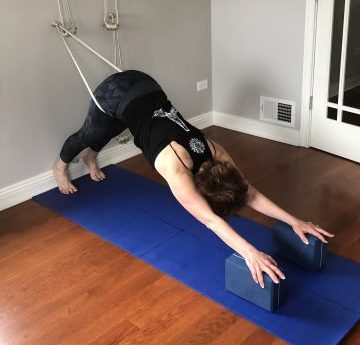One Rope Downward Facing Dog Pose can relieve back pain.
This is a version of One Rope Adho Mukha Svanasan aka Downward Facing Dog Pose when done under close supervision, that can relieve back pain. When this posture is done correctly with traction (as seen here using one low rope from a rope wall), it aligns the pelvis which is important if you have a lumbar curve or a thoraco lumbar curve. The concavity of your lumbar curve will role in. The concavity of your thoraco lumbar curve and concavity of your thoracic curve will roll in – do you homework. Take time and patience to understand the concavities and convexities of your curve pattern(s).
When practiced precisely, this version of Adho Mukha Svanasan will allow for length in the spine – both from the back body of the full erector spinae and lengthen out of the diaphragm and the pelvis in the front body. Lots of lengthening benefits to this posture including – full erector spinae, shoulders, lats, chest and rib cage, legs/hamstrings/gluts, core. Another added benefit is it will give you more lung capacity….. ahhhhh….
If there is any ONE posture you should do daily, this is it! And, it strengthens the core, the pelvis and the lower back.
Once in the posture, to align the pelvis further, get the hips as high as possible and pull the inner thighs back while tractioning. Ensure both PSIS’s are even in the hips in the posterior chain.
In a spine with scoliosis, correction of the curve pattern would also be offered in One Rope Adho Mukha Shivasan.
What does that mean?
- Right thoracic, take the right hand off the block to the matt and rotate the fingers outward.
- Higher hip – you may want to bend that knee slightly. A Certified Scoliosis Specialist will understand the anatomy and be able to cue you on this if this is needed.
- Right thoraco lumbar – take the right hand off the block to the matt and rotate the fingers outward AND lengthen thru the left waist.
- Left lumbar – pelvis has been squared. Ensure that both PSIS’s are even in the hips in the posterior chain.
- Double curve of right thoracic/left lumbar curve pattern, use cueing of each curve pattern from above.
- Opposite to the curve pattern offered, you will do the opposite cueing offered.
- Note: no more (maybe less) than 7 ujjayi breaths. Access your form – is your form perfect AND recall you still have to come out of this posture in perfect form.

Note: any discomfort or pain connotates that you are potentially reinjuring an injury AND heightening the sympathetic nervous system (fight or flight). Remember, the sympathetic is a heightened characteristic in scoliosis. You need to bring that down and increase the parasympathetic nervous system (rest or digest).
Immediately come out of the posture if uncomfortable in any way – safely, emphatically in form and and posture.
This posture can be practice for up to 7 ujjayi breaths (maybe less – never more due to the characteristic of spasming for someone with scoliosis). Even if you practice this posture daily it is highly recommended to never go into any posture (including this) for more than 7 ujjayi breaths – again maybe less. Access how you feel in the posture, keeping in mind, that in perfect form you still have to come out of this posture, in perfect form. I’m kinda a nut about perfect form – especially in a scoliotic spine.
Let me chat a bit about form pls – if you lose your form, you are prone to injury because the body just isn’t strong enough (YET….. let me add!!!) for you to continue the posture. FORM IS ABSOLUTELY IMPERATIVE GOING INTO A POSTURE AND COMING OUT OF THE POSTURE.
Note: It is important to see a doctor if your back pain is severe (5-10 on a scale of 10), has not lessened over several weeks, you have a fever, become incontinent, pain radiates out to the fingers or toes, you cannot move, or you have a severe injury or fracture. A diagnosis is helpful for treatment, and also points you in a specific direction for that treatment. It is also important to get clearance from a doctor to take a ScolioYoga or ScolioPilates class after seeking a diagnosis, in order to begin or return to these modalities.
